Talbot Armoured car
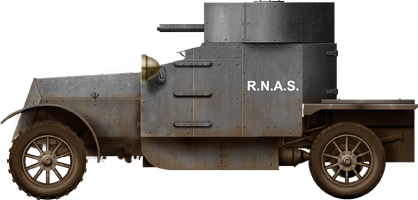
 United Kingdom - Armored car, circa 15 built 1914-1915
United Kingdom - Armored car, circa 15 built 1914-1915
The Talbot Armored Car Design
About Talbot
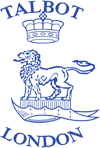 The 1902-founded British-French company Clément-Talbot was a rapprochement between Charles Chetwynd-Talbot (20th Earl of Shrewsbury) and Adolphe Clément-Bayard, which produced many vehicles prior to the First World War.
Talbot London was founded in 1903 and its first vehicles were assembled from mechanical components of French Clément-Bayard and gradually, entirely with British parts. The brand name was reduced to Talbot in 1904 but in literrature, "Clement-Talbot" is still often found. The standard 25 hp chassis was an appreciated vehicle which became one of the many purchased by the RNAS (Royal Naval Air Service), a naval air branch motorized service created in Belgium to rescue downed RNAS pilots.
The 1902-founded British-French company Clément-Talbot was a rapprochement between Charles Chetwynd-Talbot (20th Earl of Shrewsbury) and Adolphe Clément-Bayard, which produced many vehicles prior to the First World War.
Talbot London was founded in 1903 and its first vehicles were assembled from mechanical components of French Clément-Bayard and gradually, entirely with British parts. The brand name was reduced to Talbot in 1904 but in literrature, "Clement-Talbot" is still often found. The standard 25 hp chassis was an appreciated vehicle which became one of the many purchased by the RNAS (Royal Naval Air Service), a naval air branch motorized service created in Belgium to rescue downed RNAS pilots.
Three types but a few converted.
The vehicle chosen was a Clément-Talbot 25/50 hp tourer, which had a 4x2 rear-wheel drive chassis and was powered by a 4-cylinder rated for 25 horsepower (19 kW), mated to a four-speed transmission (3 fwd, 1 RR) and its original wheels judged too frail, were substituted for Warland dual-rim artillery-type wheels, with twin rear wheels (making the chassis a 2x4). This came in handy when dealing with the turret weight of the latest pattern.Admiralty 1st Pattern Clement-Talbot (1914)
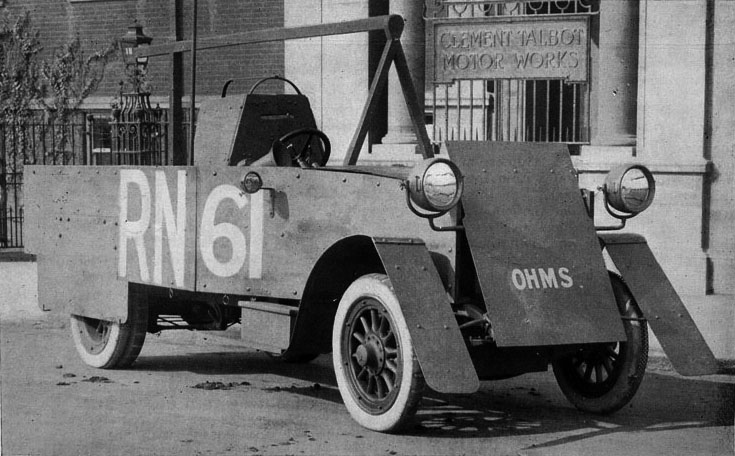
Early Vehicle of the OHMS in front of Talbot-Clement Works, 1914, credits Talbot owners club.
The RNAS (Royal Naval Air Service) operated quite an array of improvized armoured cars to recover downed pilots behind enemy lines. Commander Samson converted all models at his disposal in Belgium and notably the Clement-Talbot in the autumn of 1914. 21 were ordered to be converted, but it remains doubtful if this mount was really built. Records showed six Talbots in service in France and the Germans captured one on 9th Oct 1914 when Antwerp surrendered. These cars made in UK at Clement-Talbot first had an "Open top" configuration was similar to Rolls-Royce Cars, and often these were assimated to the latter.
The original first Admiralty pattern Talbot retook the general protective design of the Admiralty pattern Wolseley and Rolls-Royce Silver Ghosts. The final vehicle weighted 4 long tons (4.1 t) with armoured plates 8 mm (0.31 in) thick covering: The forward radiator, the sides (engine hood) and top of the same, and extending along the sides, at dashboard height. The rear plates included an insert bolted to cover most of the rear train. The forward wheels being directional, they were left unprotected, but benefited from armoured mud guards that went down quite bit to protect the tyres from front fire.
They had an open rear fighting compartment for a commander/gunner using whatever weapons at their disposal as there was no machine-gun mounted at first. There was a boxy structure protecting the driver (he was seated inside), and an additional beam assembly overhead to at least protect the crew from a possible turnover, and put a tarpaulin above for weather protection. But otherwise, crew members remained dangerously exposed to enemy fire, unless they chose to lie on the floor. Only the driver had full protection, with oddly his arms free under the box to man the wheel. He only had a small vision slit forward and thus was basically blind from nearly all sides. He probably entered the box shaped armoured hood from above and shifted into position.
The radiator shielding protecting the bonnet area was a bit taller than the hood to further protect the driver, but in practice it obscured much of the driver's vision and was probably cut down later. The final armament was one or two .303 Maxim guns mounted on pintle mounts, offside and rear in the compartment. Aoppparently a single vehicle was modified as a self-propelled gun, mounting the Navy standard QF 1-pounder pom-pom in a hull renovated for better accommodation. Some Talbots also missed as modified bith the driver's head cover and radiator shield, used as supply carriers. No doubt the design was severely limited.
Admiralty Modified 1st Pattern (1915)
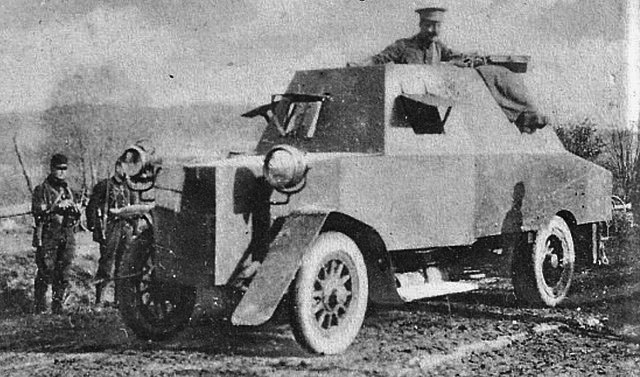
First admiralty Pattern Modified
The first Admiralty pattern was designed by Lord Wimbourne and the Admiralty Air Department (RNAS design office). He realized a full sized wooden mockup, created on a Rolls-Royce chassis. It was tested also on the Wolseley and Talbot chassis. Equivalent weights for the proposed armour each time were proposed on a base of a 30 hundredweight (1.5 t) load. The intial chassis could still hold its own, going from one to four tons, but the original wheels were definitely unsufficient. New artillery wheels were fitted, forward and twin ones at the rear. The armour was assembled, riveted, at the Royal Navy Dockyards at Sheerness. These prototypes were used by Samson in France and Belgium, starting operation by October 1914. In all, 60 armoured cars were ordered and the majority of the 15 delivered first were Talbots.
By November 1914, five Talbots and one RR were modified to a common design to the Dunkerque yard. The idea was to improve poor crew protection compared to the earlier vehicles, giving birth to a second variant. Others were converted. These "late" Talbots had a raised armour and reduced protection lower to better balance the weight and stability. As these were modified on an individual basis, sub-types emerged with two different types of hull, long and short.
So six first Admiralty pattern Talbot armoured cars were modified in France with its radiator shield replaced by a better system of side-opening doors. The rear wheel protection was removed but a rear armoured bodywork was built up around the fighting compartment, to shoulder height, of the crew was standing. This new six-faceted structure, slightly sloped on the upper part, also encompassed the driver, which got rid of the former "blind box". The armament this time comprised either two .303 Maxim guns or a single one, under a gun shield.
Admiralty Modified 1st Pattern, Turret (1915)
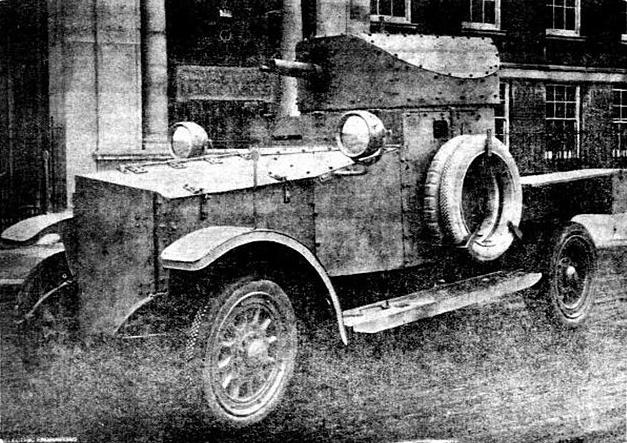
First Modified Admiralty Pattern Turret
In 1915 three more Talbot were converted into the new Admiralty turreted pattern, in a design very resminsicent of the Rolls-Royce Admiralty turreted pattern. There was a new armoured hull, and the common fighting compartment/driver cab was all-armoured with folding shutters, and with a two man turret mounted above and a rear cargo area. The chassis was also upgraded to the new Warland artillery-type wheels, and there was a slightly different and better radiator, which armour was also modified. But otherwise, they were very similar to the Rolls.
Talbots or Delaunay Belleville ?
The Talbots and Delaunay-Belleville were hard to distinguish at first. They were converted out of necessity in the Autumn 1914 with improvised armour. Then, the Admiralty produced a standard body that could be fitted to all types and thus, Talbots and Delaunay-Belleville received the same kit and became identical. The Lanchester and Rolls-Royce versions had the same, but modified armoured body to fit correctly.Of course paperwork was not done during these improvized conversions, and thus little information is available but their official name. Five Talbots and one RR had the initial open top improvised armour and just three RR were avilable in France at the time, others still under construction in Britain. Wolseleys were considered but dropped due to power-to-weight ratio for further upgrades. Some kept their open top armor and later others were stripped and used as normal tenders.
What is sure is that three turreted Delaunay-Bellevilles were built in Dunkirk and appeared at the same time as the improved Talbots and Rolls-Royce. These turreted Delaunay-Belleville were the base for the definition of the later turreted pattern turrets applied to the RR and Lanchesters.
One officer from Samson's squadron in fact came back to Britain to work at the Admiralty officer to the creation of a universal turret design which could be fitted to all Admiralty Pattern Vehicles, whatever their manufacturer. Turreted armoured cars started to appear in october. But the first deplpoyed after the three Delaunay were the RR and Lanchesters. Meanwhile, the Talbots were fitted for some, on a per-unit basis (per regiment) and as privately funded projects, based on the Admiralty model turret used on the Rolls Royce. It is said that RNAS engineers carefully studied the Belgian SAVA while in Antwerp.
The Talbot Armored Car in Action
The Talbot followed a well-established pattern with early successes using hastily armoured cars under Commander Charles Samson. He wanted sixty armoured cars built in Britain:-18 Rolls-Royce 40/50 hp Chassis
-21 Wolseley 30 hp chassis
-21 Talbot 25/50 hp tourers.
Clément-Talbot in North Kensington provided an unknown number of chassis. If 21 were indeed delivered, we only had information about the later Pattern conversion, 6 of the Modified Type and 3 of the Turret type, so nine, in addition (or succession ?) of an unknown number of early conversions.
First Admiralty pattern proved unpopular due to the widely open fighting compartment, exposed from the waist up. So six new vehicles were redesigned with increase crew protection in mind. The earlier ones were either reconverted to supply vehicle or completely stripped off and used as liaison vehicles. Modifications for a modified Pattern were made in France, at the Dunkirk's Forges et Chantiers de France, under supervision of Lieutenant F. R. Samson himeslf. He used the stock of armour plate sent to him by the Admiralty back in October. By November 1914 however the Western Front froze in trench warfare. The vehicles now lacked employment opportunities. They were sent to the still open front Bassée area for action.
The new six upper open-topped designs were found not sucessful enough for Charles Samson, which ordered Forges et Chantiers de France to create three new prototype with this time the newly arrived Admiraklty standard turret. It was fitted on the chassis of locally found three luxury French Delaunay-Belleville tourers, and not Talbots, on designs from Captain Arthur Nickerson (which created the Delaunay-Belleville armoured car).
The Admiralty Air Department formed a committee to rationalize this new turreted armoured car, but based on the Rolls-Royce chassis. Three Rolls-Royce Admiralty turreted pattern were completed in Dunkirk by December 1914/ By early 1915 three Talbot 25/50 hp chassis were also fitted with the same hull exatcly. In fact they were tested against the Rolls-Royce and Lanchesters, and the Talbot suspension was found to be too fragile for more conversion, so the project was terminated. In all, Samson was able to create three equipped four-car sections in the R.N.A.S. Armoured Car Division. They served in the same squadron as the Delauney-Bellevilles, but soon the Talbots still in service were stripped and converted to logistics tenders, resupplying the Rolls-Royce and Lanchester, and still probably in use when the RNAS unit was transferred to the British Army.
It became customary to name these vehicles for a daily basis operations: Four out of the five vehicles had names derived from RNAS recent battles. These were HMS Aniche, HMS Cassel, HMS Orchies and HMS Douai. The "long hull" version had a long end after the rear axl. They were also reported camouflaged, applied over their oginal blue-grey Naval Livery, by Cdr Samson.
So to resume:
-5? "Admiralty 1st Pattern Clement-Talbot" (open top)
-5 "Modified Admiralty 1st Pattern Clement-Talbots" with upgraded armor.
Further Reading
List: Sava 1914 Model - Rolls-Royce Silver Ghost - RNAS Silver Ghost Admiralty Turret Pattern - Talbot improvized Type - Talbot Admiralty Mod & Turret Pattern - Delaunary Belleville Admiralty Mod & Turret Pattern - Lanchester Admiraklty Pattern - Wolseley Improvized Type - Peerless armoured car - Austin RNAS Pattern - Sizaire Berwick armoured car - Seabrook armoured truck - Pierce-Arrow armoured lorry.Src
Book: Talbot in the First World War by Stephen Lally & John Tomsett published (2008)Bartholomew, E. (1988). Early Armoured Cars. Aylesbury: Shire Publications Ltd. pp. 13–22.
Foss, Christopher F. (2002). The Encyclopedia of Tanks & Armoured Fighting Vehicles. London: Amber Books.
White, Brian Terance (1970). Tanks and other armoured fighting vehicles: 1900-1918. London: Blandford Press Ltd.
Fletcher, David (1987). War Cars: British Armoured cars in the First World War. London: Her Majesty's Stationery Office.
Wiki
The Talbot Armored Car - landships II
The Talbot Owners club
The Talbot kit
The Delaunay-Belleville AC
warwheels.net (turret)
wardrawings.be
geocities.ws
| Clement-Talbot 1st admiralty pattern (mod) | |
Dimensions | Unknown, circa 16 ft x 7 ft x 10 ft |
| Total weight, battle ready | Circa 4 long tons (4.1 t) |
| Crew | 3 (commander, driver, 1 machine-gunner) |
| Propulsion | 4-cylinder Talbot-Clement 25 hp (19 kW) 4F1R Transmission |
| Speed | Circa 30 mph (50 kph) |
| Suspensions | 4x2 leaf springs |
| Range | Lower than 200 km (125 mi) |
| Armament | 1 or 2 Maxim Water cooled cal.303 (7.69 mm) machine gun |
| Armor | Maximum 0.31 in (8 mm) |
| Total production (all combined) | Unknown, Circa 15 (6+6+3) |

Talbot Admiralty Pattern Mk.II, Turreted, late 1915
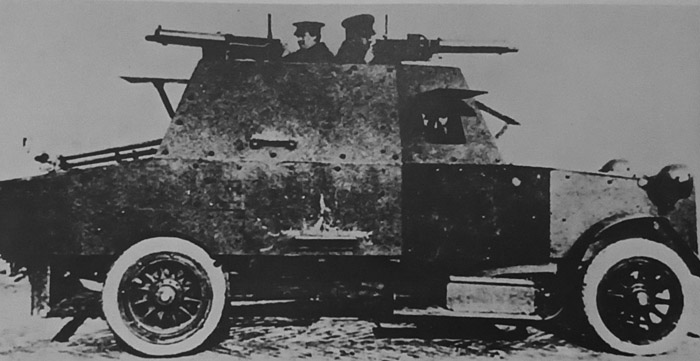

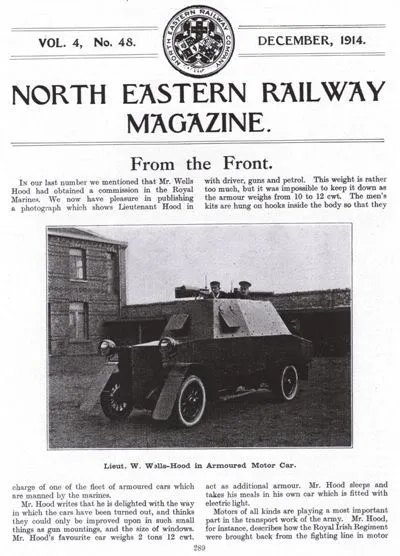
See also and "HMS Aniche" from Dunkirk Yard and the earlier variant 1 2 3 (a column, showing at least 5 vehicles converted at Clement-Talbot) 4 Type 1 used as supply vehicle 5 - Type 2 in Ghent, Belgium all colorized by Jose Luis Castillo. Main src

The Great War
 Austria-Hungary
Austria-Hungary Belgium
Belgium British Empire
British Empire France
France German Empire
German Empire Italy
Italy Russia
Russia USA
USAWW1 tanks posters
